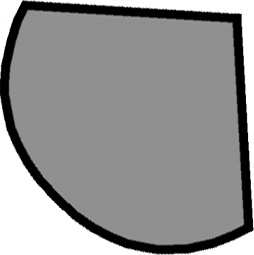Anatomy of a Tag
We don’t have enough space to get into the details of all the tags defined in the SWF specification. However, it is worthwhile to step through one tag as an example of how the fields of a definition tag are structured. This section presents the DefineShape3 tag, which is used to describe arbitrary shapes. The shape we’re describing is pictured in Figure 8-3.

This shape is represented in a mere 44 bytes; if you tack on an SWF header, a PlaceObject, and an end tag to make a complete SWF file, the total is 81 bytes. A similar shape in SVG would take up almost five times as many bytes.
The raw binary data (44 bytes) that makes up the tag for the shape in Figure 8-3 looks like this:
0x2a 0x08 0x01 0x00 0x70 0x14 0x0c 0x30 0x01 0x40 0x91 0x00 0x01 0x00 0xff 0x00 0x00 0xff 0x01 0x50 0x00 0x7f 0x00 0x00 0xff 0x11 0x35 0x2c 0x86 0x47 0xe0 0xbb 0x87 0x8a 0x26 0x16 0x51 0x20 0x00 0x00 0x00 0x17 0x68 0x00
A DefineShape3 tag is composed of seven pieces (also shown in Table 8-3 and described in detail in the following sections).
A tag header that contains a code indicating the type of the tag and the length of the body of the tag (in bytes).
A character id that uniquely identifies this shape in the dictionary.
The bounding box, a data structure containing the coordinates of the rectangle that encloses the ...
Get Perl Graphics Programming now with the O’Reilly learning platform.
O’Reilly members experience books, live events, courses curated by job role, and more from O’Reilly and nearly 200 top publishers.

